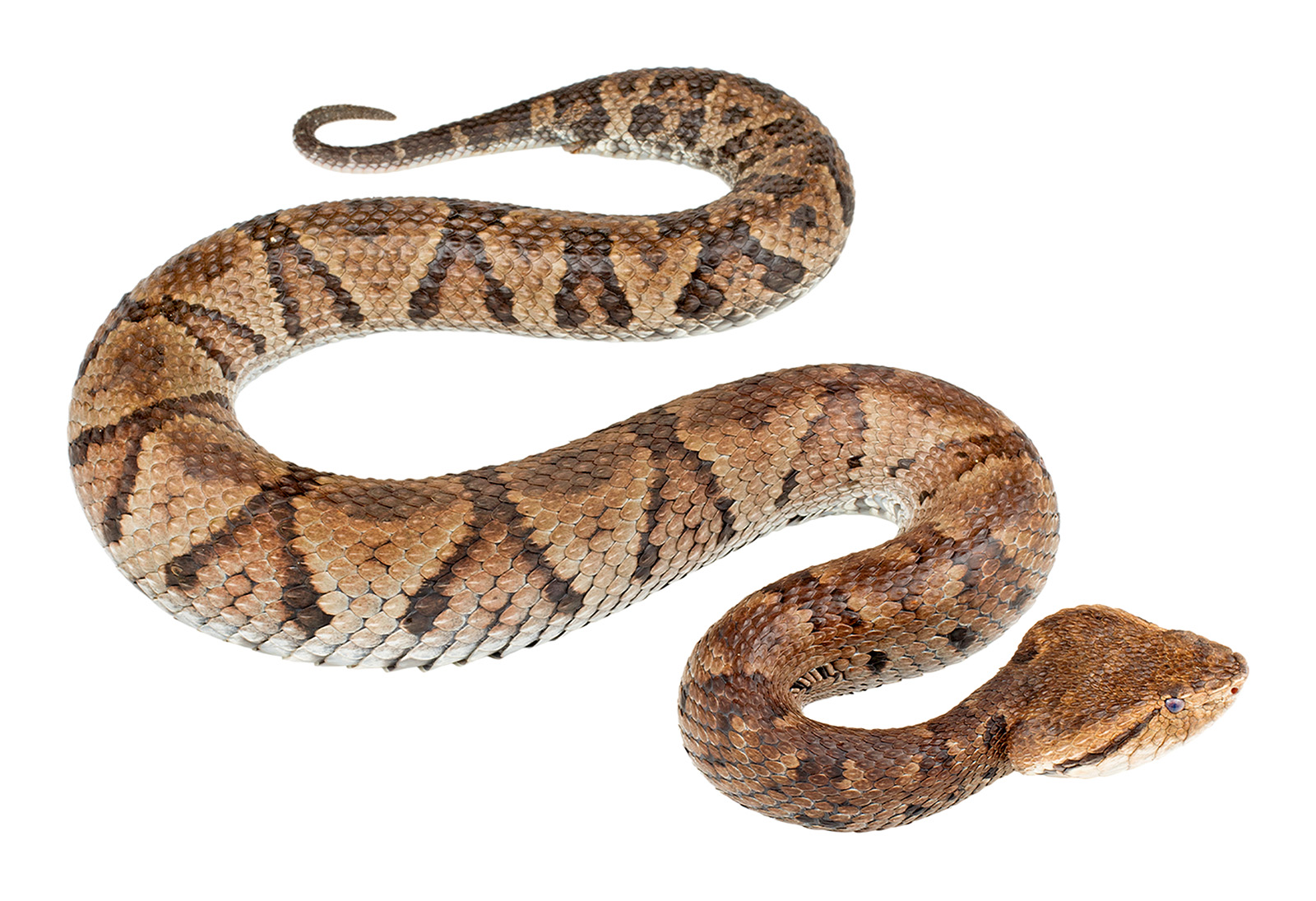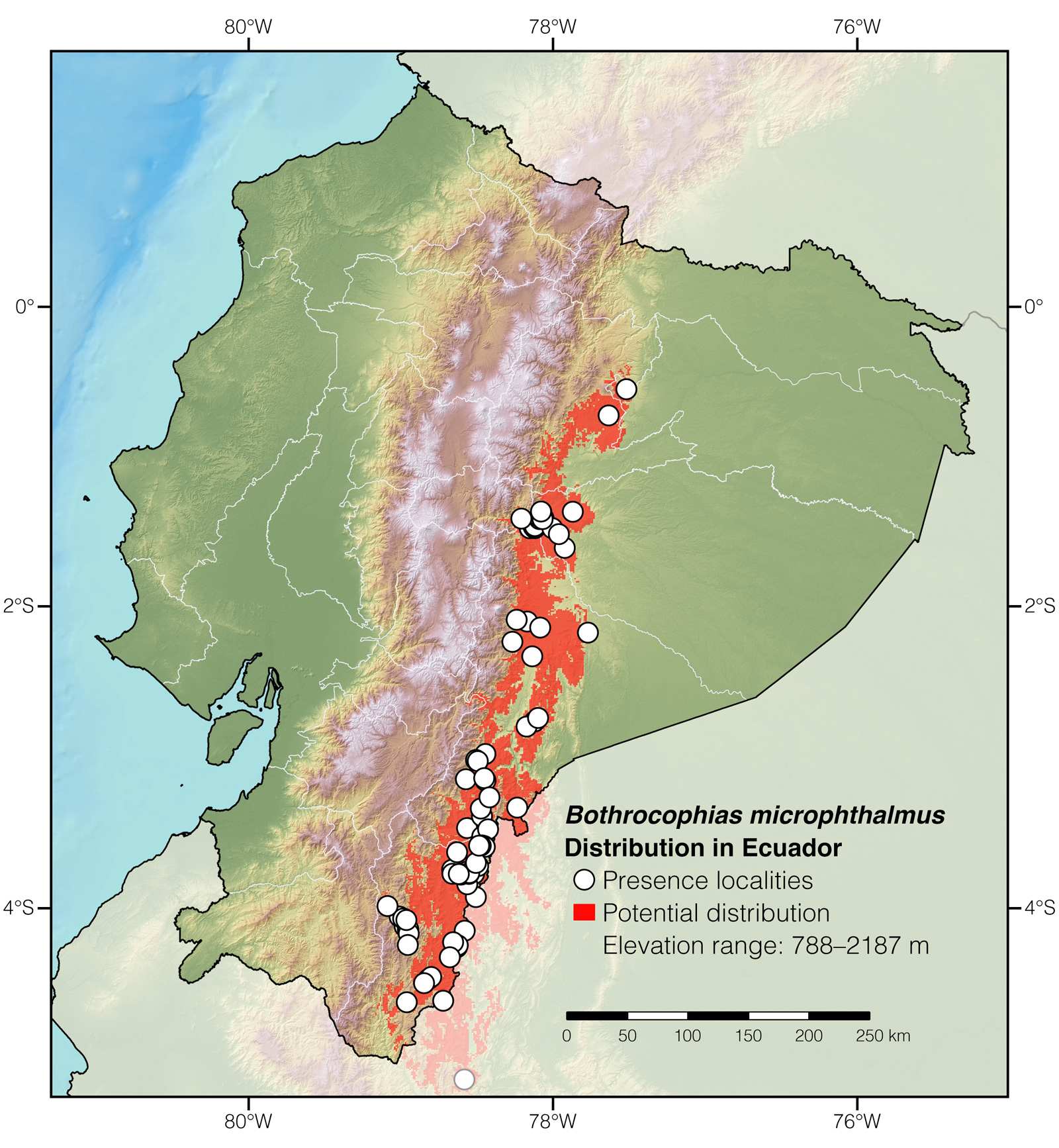Small-eyed Toadhead |
Reptiles of Ecuador | Serpentes | Viperidae | Bothrocophias microphthalmus
English common names: Small-eyed Toadhead, Small-eyed Toad-headed Pitviper.
Spanish common names: hoja podrida (Ecuador), jergón pudridora (Peru).
Recognition: ♂♂ 78 cmMaximum distance from the snout to the tip of the tail. ♀♀ 132 cmMaximum distance from the snout to the tip of the tail.. The Small-eyed Toadhead (Bothrocophias microphthalmus) may be identified by having a triangular-shaped head, heat-sensing pits between the eyes and nostrils, an upturned snout, prominent knoblike keels on the dorsal scales, and a dorsal pattern of 12–20 dark X-shaped markings on a brownish (yellowish in some juveniles) dorsum.1,2 Bothrocophias microphthalmus is often confused with B. hyoprora, a species occurring generally at lower elevations.3 Individuals of B. hyoprora are smaller, have a pattern of trapezoidal blotches rather than X-shaped markings, and have entire subcaudal scales.1
Picture: Adult female from Centro Shuar Tiink, Morona Santiago, Ecuador. | |
 | |
Natural history: UncommonUnlikely to be seen more than once every few months. to locally frequentRecorded weekly in densities below five individuals per locality.. Bothrocophias microphthalmus is a nocturnal snake that inhabits old-growth to moderately disturbed evergreen montane forests, forest borders, and cassava plantations,1 usually close to streams and rivers.4 It prefers areas where the mean annual temperature is ~21° C, whereas the Amazonian Toadhead (B. hyoprora) prefers areas where the mean annual temperature is ~25° C.3
Throughout the day, individuals of Bothrocophias microphthalmus typically remain inactive and coiled on the forest floor (usually among herbaceous vegetation or besides buttress roots) or sheltered below leaf-litter and logs.1 Others remain out in the open, basking in direct sunlight or moving at ground level.4 Within about an hour of sunset, most vipers emerge from their hideouts and move to their nocturnal ambush sites. Small-eyed Toadheads usually dwell on soil, leaf-litter, and rock ledges, but may as well perch on low vegetation 0.4–1 m above the ground.4
Small-eyed Toad-headed Pivipers are ambush predators. Their diet includes rodents,5,6 opossums,7 frogs (such as Boana almendarizae, B. fasciata, and B. lanciformis),8–10 whiptails8, microteiids (such as P. strangulatus),5 and geckos (such as Lepidoblepharis festae),9 and lizard eggs.1 Juveniles also include insects in their diet.10
Individuals of Bothrocophias microphthalmus rely on their camouflage as a primary defense mechanism. When threatened, some individuals give a “warning” by vigorously wiggling their tail against the leaf-litter whereas others just readily bite if attacked or harassed.1 Members of this species are preyed upon by eagles.1
Bothrocophias microphthalmus is a venomous species (LD50 13.2 mg/kg)11 that is responsible for ~1.5% of snakebites in some areas.12 In humans, its venom causes intense pain, swelling, blistering, and necrosis (death of tissues and cells).12,13 In poorly managed or untreated cases, the venom can cause amputations13 and presumably also death.
What to do if you are bitten by a Small-eyed Toad-headed Pitviper?
|
Females of this species “give birth” (the eggs hatch within the mother) to 6–47 young that are 14.8–20.3 cm in total length.7,13 It is hypothesized that hybridization between individuals of Bothrocophias microphthalmus and B. hyoprora occurs in the wild,3 but this has not been confirmed. Under human care, individuals can live up to ~16 years, and probably much longer.16
Conservation: Least Concern.17 Bothrocophias microphthalmus is listed in this category because the species is distributed over an area which retains most of its forest cover, and therefore, is considered to be facing no major immediate threats of extinction. We estimate that, in Ecuador, ~68.9% of the habitat of B. microphthalmus holds pristine forest. The most important threat to the long-term survival of the species is habitat destruction mostly due to mining and the expansion of the agricultural frontier.1
Distribution: Bothrocophias microphthalmus is native to the Amazonian foothills of the Andes in Bolivia, Colombia, Ecuador, and Perú.3 In Ecuador, the species occurs over an estimated 16,990 km2 area.

Etymology: The generic name Bothrocophias, which is derived from the Greek words bothros (meaning “pit”) and kophias (meaning “snake”), refers to the heat-sensing pits between the eyes and nostrils. The specific epithet microphthalmus, which is derived from the Greek words mikros (meaning “small”) and ophthalmus (meaning “eye”), refers to the comparatively small eyes of members of this species.18
See it in the wild: Small-eyed Toad-headed Pitvipers can be located with ~1–3% certainty in forested areas throughout the species' area of distribution in Ecuador. Some of the best localities to find the vipers are Río Anzu Reserve, Río Zuñac Reserve, Maycu Reserve, and Podocarpus National Park. The snakes are most easily located by walking along trails at night.
Special thanks to Sam Schenker for symbolically adopting the Small-eyed Toad-headed Pitviper and helping bring the Reptiles of Ecuador book project to life.
Click here to adopt a species.
Author: Alejandro ArteagaaAffiliation: Fundación Khamai, Reserva Arlequín, Ecoruta Paseo del Quinde km 56, Santa Rosa de Mindo, Pichincha 171202, Ecuador.
Photographers: Jose VieiraaAffiliation: Tropical Herping (TH), Quito, Ecuador.,bAffiliation: ExSitu, Quito, Ecuador.
How to cite? Arteaga A (2020) Bothrocophias microphthalmus. In: Arteaga A, Bustamante L, Vieira J (Eds) Reptiles of Ecuador: Life in the middle of the world. Available from: www.reptilesofecuador.com
Literature cited:
- Valencia JH, Garzón-Tello K, Barragán-Paladines ME (2016) Serpientes venenosas del Ecuador: sistemática, taxonomía, historial natural, conservación, envenenamiento y aspectos antropológicos. Fundación Herpetológica Gustavo Orcés, Quito, 653 pp.
- Harvey MB, Aparicio J, Gonzales L (2009) Revision of the venomous snakes of Bolivia. II. The pitvipers (Serpentes: Viperidae). Annals of the Carnegie Museum 74: 1–37. DOI: 10.2992/0097-4463(2005)74[1:ROTVSO]2.0.CO;2
- Vaca-Guerrero JE (2012) Biogeografía del género Bothrocophias (Serpentes: Viperidae: Crotalinae), mediante modelamientos de nicho ecológico. BSc Thesis, Universidad Central del Ecuador, 116 pp.
- Field notes, Reptiles of Ecuador book project.
- Field notes of Darwin Núñez.
- Torres-Carvajal O, Pazmiño-Otamendi G, Salazar-Valenzuela D (2019) Reptiles of Ecuador: a resource-rich online portal, with dynamic checklists and photographic guides. Amphibian & Reptile Conservation 13: 209–229.
- Cisneros-Heredia DF, Borja MO, Proaño D, Touzet JM (2006) Distribution and natural history of the Ecuadorian toad-headed pitvipers of the genus Bothrocophias. Herpetozoa 19: 17–26.
- Prado A, Hoge RA (1947) Notas ofidiológicas. Observações sobre serpentes do Perú. Memórias do Instituto Butantan 20: 283–296.
- Dueñas MR, Valencia JH (2018) Bothrocophias microphthalmus (Small-eyed Toad-headed Pitviper). Habitat use and diet. Herpetological Review 49: 542.
- Bentley A, Reyes JP (2019) Bothrocophias microphthalmus (Small-eyed Toad-headed Pitviper). Diet. Herpetological Review 50: 149.
- Terán MC, Lomonte B (2016) Actividad letal de seis venenos de serpientes de importancia médica en el Ecuador. Revista Ecuatoriana de Medicina y Ciencias Biológicas 37: 25–30.
- Warrell DA (2004) Snakebites in Central and South America: epidemiology, clinical features, and clinical management. In: Campbell JA, Lamar WW (Eds) The Venomous reptiles of the Western Hemisphere. Cornell University Press, Ithaca, 709–761.
- Kuch U, Freire A (1995) Notes on morphology, reproduction and medical importance of the poorly known Small-eyed Lancehead Bothrops microphthalmus COPE, 1876, in Ecuador. Herpetozoa 8: 81–83.
- Hardy DL (1994) Bothrops asper (Viperidae) snakebite and field researchers in Middle America. Biotropica 26: 198–207.
- Avau B, Borra V, Vandekerckhove P, De Buck E (2016) The treatment of snake bites in a first aid setting: a systematic review. PLoS Neglected Tropical Diseases 10: e0005079. DOI: 10.1371/journal.pntd.0005079
- Ernesto Arbeláez, pers. comm.
- Caicedo JR, Calderón M, Hladki AI, Ramírez Pinilla M, Renjifo J, Urbina N (2019) Bothrocophias microphthalmus. The IUCN Red List of threatened species. Available from: www.iucnredlist.org
- Campbell JA, Lamar WW (2004) The venomous reptiles of the western hemisphere. Cornell University Press, Ithaca, 774 pp.
- Field notes of Ernesto Arbeláez.